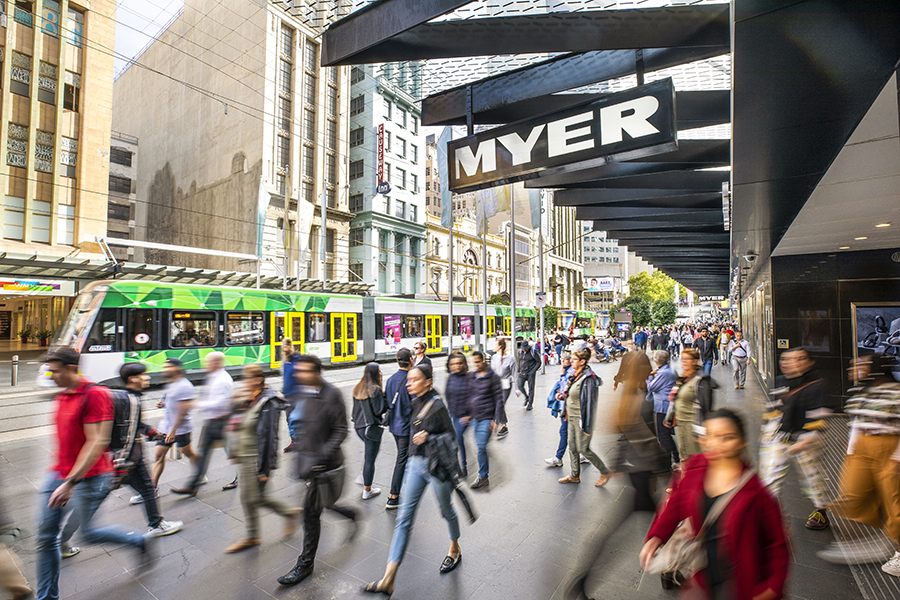Melbourne is leading the national CBD retail recovery, with the city’s vacancy rate in the single figures after plummeting by 5.6 percentage points. Nationwide, Australia’s CBD retail vacancy rate tightened from 15.9% in H1 2022 to 13.9% in H2 in a lagged recovery from pandemic-related hardships, new CBRE data shows.
Higher office occupancies, surging inbound tourism and returning international students have all contributed to the stronger outlook according to CBRE’s H2 CBD Retail Vacancy report, which surveyed 5,347 retail outlets across Sydney, Melbourne, Brisbane, Perth and Adelaide.
Melbourne was a clear standout, with the city’s vacancy rate shrinking to 9.2%. Adelaide followed, with a 3.71 percentage point vacancy dip while Perth’s vacancy declined marginally by 0.41 percentage points.
While Sydney’s CBD vacancy remains the country’s lowest at 8.3%, there was a marginal increase in H2 (+1.39 percentage points). Brisbane was the only other CBD to record a vacancy increase (+0.28 percentage points to 18.4%).
CBRE’s Australian Head of Retail Research Kate Bailey noted, “Despite the heightened cost of living pressures, there were healthy levels of discretionary spending in H2, with the re-opening of China’s borders expected to provide another boost to the country’s CBD retail markets. Retailers are also on the expansion trail, with our latest Asia Pacific Retail Flash Survey showing that 83% of Australian respondents plan to grow their store networks this year, with 61% planning to increase the quality of their store locations – a move which will favour CBD markets.”
Around the Grounds:
Sydney
From an extremely tight vacancy rate of 6.9% in H1 2022, Sydney’s CBD vacancy rate increased slightly by 139bps to 8.3% in H2.
CBRE’s Australian Head of Retail Leasing, Leif Olson, noted that Sydney still had the lowest CBD vacancy rate in the country, driven by increases in office occupancy, tourism and international students, with 2022 NSW enrolments to November totalling 289,098 – just 5% shy of the five-year pre-COVID average.
“Chinese students are expected to quickly flow into Australia this year after the Chinese education ministry warned that overseas online learning would no longer be recognised. This presents an opportunity for increased CBD retail demand as does the strong pipeline of projects that have been proposed to revitalise the city,” Olson said.
The Galeries, Sydney
A breakdown of the CBD vacancy shows that the H2 increase was largely driven by strip retail, with the vacancy in this sector climbing 3.79 percentage points to 10.11%. The increase was particularly pronounced on Pitt Street, potentially due to the area’s extremely high rents relative to the other capital city markets.
“Notwithstanding this, we’ve seen demand increase from national and international brands for prime locations on George and Pitt Streets off the back of strong sales and increasing office occupancy rates. This has been demonstrated by several flagship stores committing to George Street off the back of a number of initiatives including the City of Sydney pedestrianisation extension, The Long Lunch event and World Pride bringing more people to the city,” Olson noted.
“Experienced CBD food & beverage operators are also active and expanding, particularly in the city’s western corridor, with tourists notably visiting the city and spending,” Olson noted.
Melbourne
Melbourne was the come-back kid in H2, 2022. After bearing the brunt of COVID lockdowns and border closures, the city’s vacancy dropped by a staggering 567bps as office occupancy rates surged and CBD spending in December surpassed 2019 inflation-adjusted levels, reaching $31.68 million.
CBRE Associate Director, Retail Leasing, Jason Orenbuch said the significant decline, particularly in centre retail properties in the CBD, could be partly attributed to traditional leasing demand in the lead-up to Christmas and the holiday period, with specialty pop-up shops filling many vacant stores.
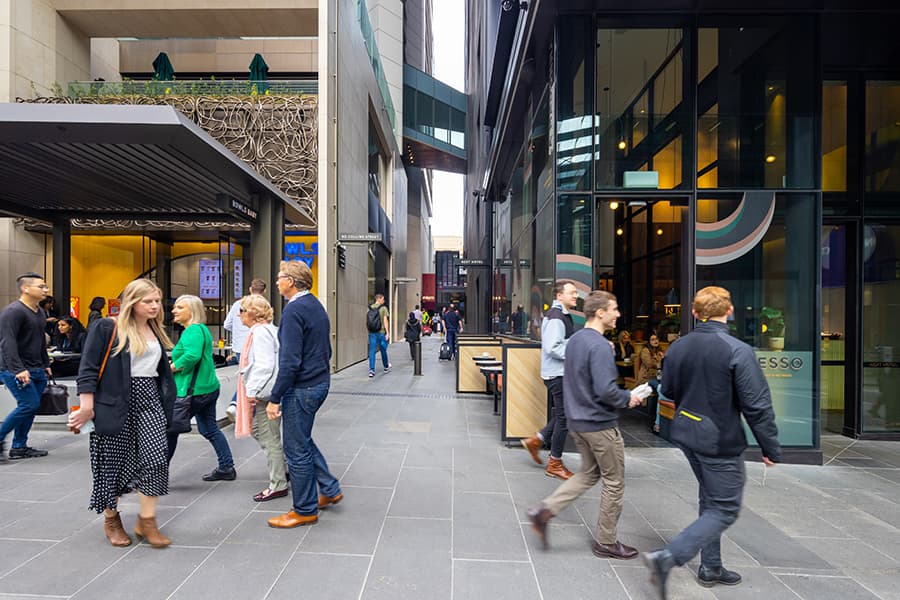
80 Collins, Melbourne
“While these pop-up lease terms are generally short, they’ve enhanced shopper visitation and there is more buzz in the city. Takeaway food outlets have also filled many vacancies as international students return, tourism rebounds and office occupancies increase. We’re also seeing particularly strong interest from hospitality operators for partially or fully fitted out space in hospitality hotspots such as Flinders Lane and Swanston Street,” Orenbuch noted.
Events have been another boon for the CBD retail market, with the AFL Grand Final bringing thousands of fans to the city, providing a boost to surrounding restaurants and pubs and an estimated $294 million spend.
CBRE’s report also notes a continued “flight to quality” in the Melbourne CBD retail market, with prime areas proving to be more resilient than secondary locations, which are experiencing a slower recovery.
Brisbane
Brisbane’s CBD vacancy remained relatively stable in H2, rising just 28bps after a large jump in H1.
CBRE Associate Director, Retail Leasing, Tanaka Jabangwe said low office occupancy rates, severe weather events and low levels of overseas migration and tourism over the past two to three years had created a volatile environment for retailers. However, positive signs were emerging with the return of international tourists and the resumption of major events in H2 such as The Ekka – the largest event to be held in Brisbane since the pandemic – which had injected $200 million into the Brisbane economy.
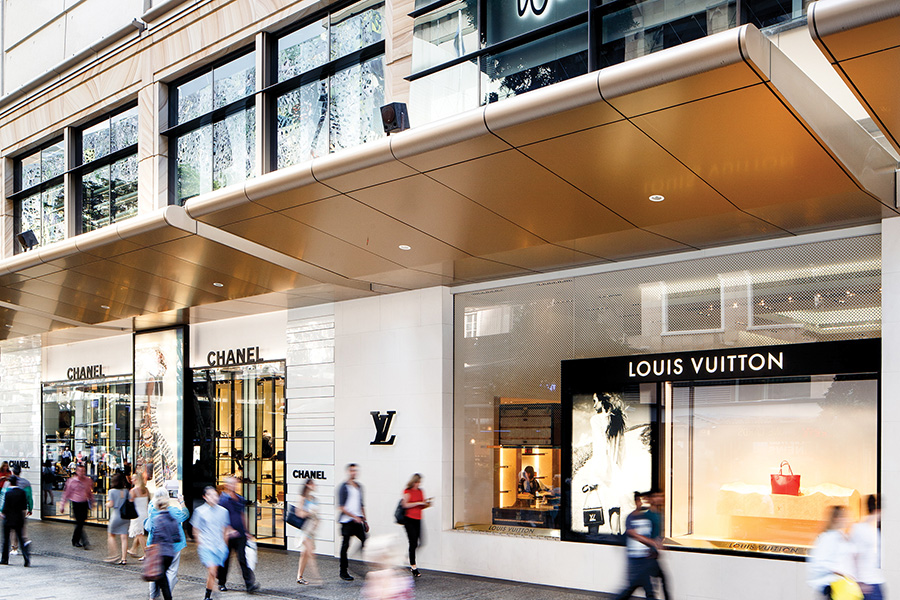
QueensPlaza, Brisbane
“A break-down of the CBD vacancy shows that the H2 increase was wholly attributable to centre vacancies, with the city welcoming a range of new retailers to its retail strips, where the vacancy tightened by 13bps,” Jabangwe said.
“Enquiry levels for super prime strip tenancies are high, with strong demand for flagship stores, as highlighted by Footlocker and Glue Store committing to new Queen Street Mall locations. In response to an influx of inner-city residents, there has also been a surge in convenience store and take-away food leases, involving tenants such as EzyMart and KFC, with new food courts also set to open in 300 Queen Street and 400 George Street.”
Adelaide
After jumping 260bps in H1 2022 in a lagged response to COVID-19 pressures, Adelaide’s CBD vacancy dropped by a staggering 371bps to 13.3% in H2.
Julia Pottenger, CBRE Associate Director, Retail Leasing, said the city had been buoyed by the reintroduction of major events and end-of-year shows, as well as the return of major cruise ships in November and December, which drove strong retail expenditure, particularly in luxury goods, clothing, and food retailing.
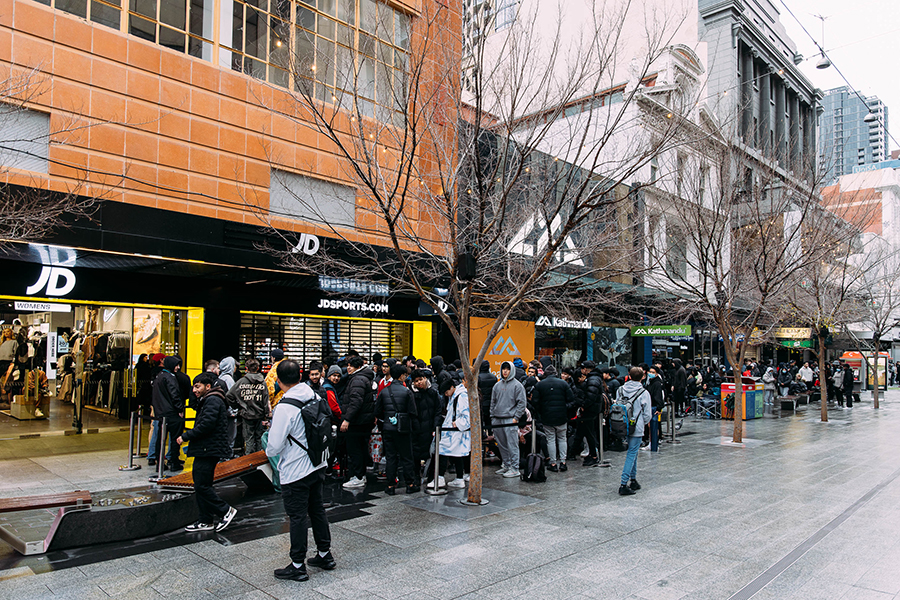
JD Sports opening, Rundle Mall Adelaide
Centre vacancies dropped most significantly, by 732bps, following ground floor openings in the Myer Centre of Uniqlo for its first South Australian store and Lush for its first Australian concept store, with multiple other CBD centre leases to small clothing and takeaway food retailers.
Arcade vacancies also dropped, with a jewellery and a clothing store lease reducing Adelaide Arcade’s vacancy to 0%.
Rundle Mall’s vacancy rose by 299bps off a low base, with Factorie, Typo and Sussan vacating. However, Pottenger said that the Sussan site has been leased to lululemon and both other sites were under offer to major national retailers.
“The Mall has received attention from high-profile tenants, particularly around the western end which has historically seen higher levels of vacancy. This demand comes off the back of major international brands like Uniqlo opening flagship Adelaide stores and highlights the flight-to-quality and experiential retail trends we’re seeing across the country,” Pottenger said.
“Off-market deals for space in Rundle Mall have also surged, indicating a competitive leasing market for occupiers.”
Pottenger noted that further market stimulus was expected as the council sought support for extended trading hours the aid the recovery of the CBD’s nighttime economy.
Perth
After feeling the impacts of lengthy border closures and COVID restrictions, Perth’s CBD retail vacancy tightened 41bps to 26.1% in H1.
CBRE Senior Director & WA Head of Retail Fred Clohessy said Perth’s office occupancy rate had rebounded to 80% in November – the highest in the country – post the easing of restrictions. This had provided much-needed relief for CBD retailers, with the return of events, tourists and overseas students, combined with WA’s economic fundamentals, providing an optimistic outlook for 2023.
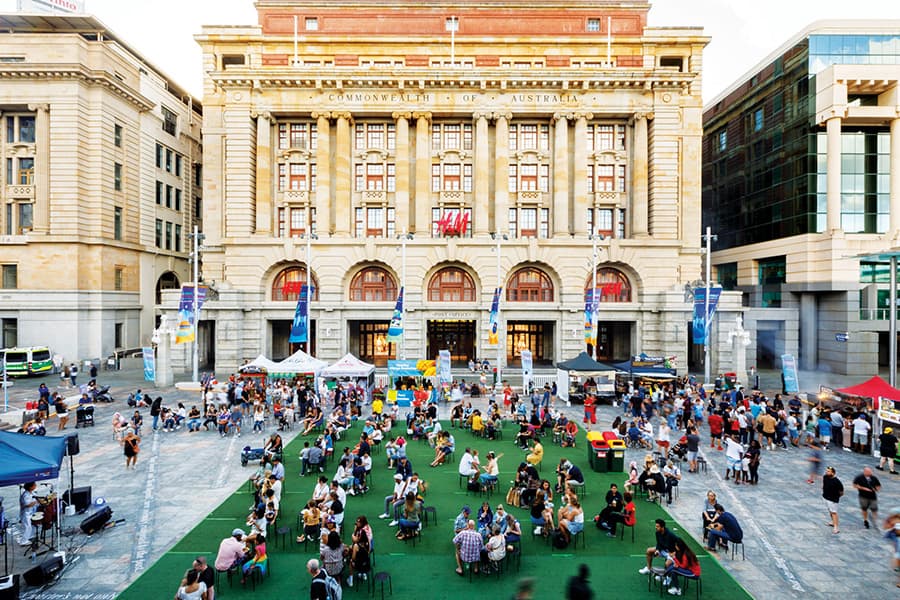
Perth CBD
“Retailer interest and enquiry was re-established in late 2022, when confidence returned in travelling to and from Perth and this has carried into 2023 – a trend which should slowly breakdown the CBD’s high retail vacancy rate,” Clohessy said.
“We’ve already seen partial evidence of this in the strip retail market, where the vacancy dropped 80bps to 25.7% in H2. The high-profile store opening of Sephora in Murray Street Mall contributed to this, with people lining up from as early as 3.30am on opening day and hundreds of people heading through the door.”
“Demand for prime space from luxury brands is having a positive effect on rents and will help reduce vacancy levels, particularly in strip locations. However, rents are still correcting on the Hay Street Mall and in secondary locations.”


